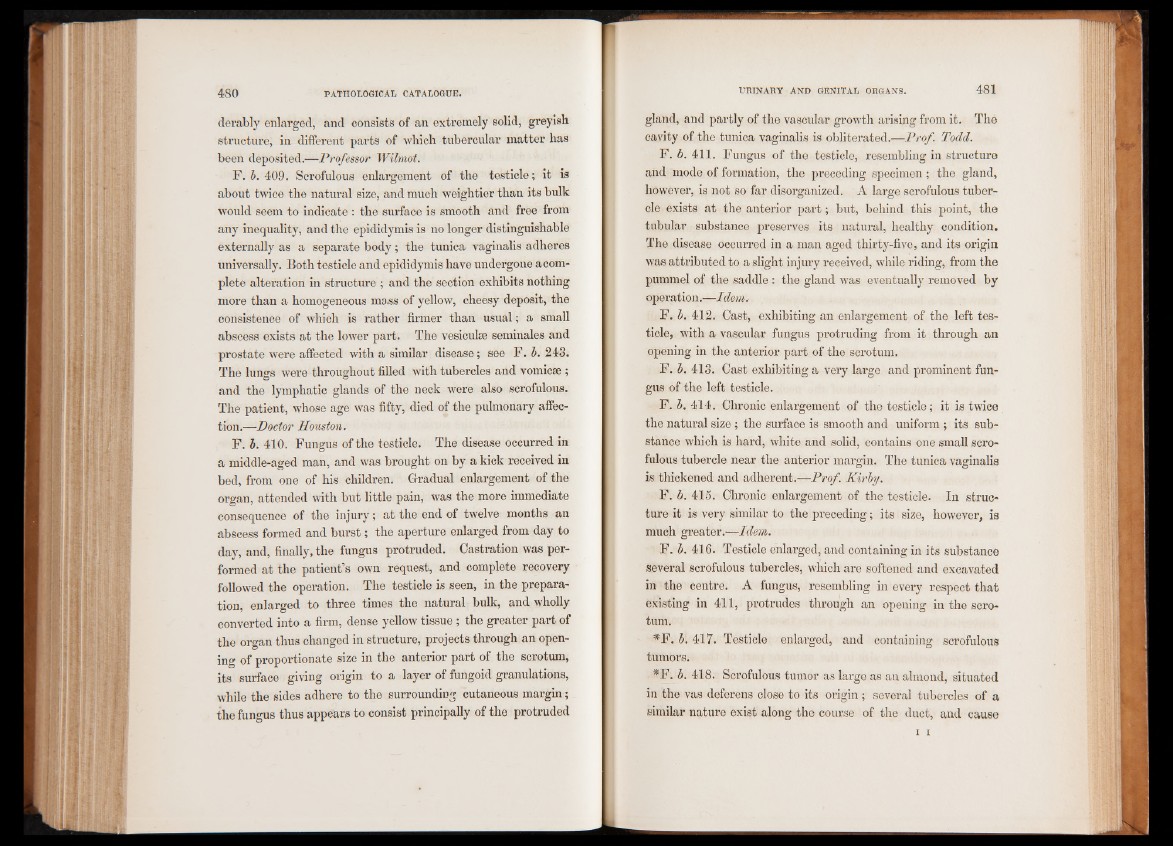
derably enlarged, and consists of an extremely solid, greyish
structure, in different parts of which tubercular matter has
been deposited.—Professor Wilmot.
F. b. 409. Scrofulous enlargement of the testicle; it is
about twice the natural size, and much weightier than its bulk
would seem to indicate : the surface is smooth and free from
any inequality, and the epididymis is no longer distinguishable
externally as a separate body; the tunica vaginalis adheres
universally. Both testicle and epididymis have undergone a complete
alteration in structure ; and the section exhibits nothing
more than a homogeneous mass of yellow, cheesy deposit, the
consistence of which is rather firmer than usual; a small
abscess exists at the lower part. The vesiculse seminales and
prostate were affected with a similar disease; see F. b. 243.
The lunars were throughout filled with tubercles and vomicae ;
and the lymphatic glands of the neck were also scrofulous.
The patient, whose age was fifty, died of the pulmonary affection.—
Doctor Houston.
F. b. 410. Fungus of the testicle. The disease occurred in
a middle-aged man, and was brought on by a kick received in
bed, from one of his children. Gradual enlargement of the
organ, attended with but little pain, was the more immediate
consequence of the injury; at the end of twelve months an
abscess formed and burst; the aperture enlarged from day to
day, and, finally, the fungus protruded. Castration was performed
at the patient’s own request, and complete recovery
followed the operation. The testicle is seen, in the preparation,
enlarged to three times the natural bulk, and wholly
converted into a firm, dense yellow tissue ; the greater part of
the organ thus changed in structure, projects through an opening
of proportionate size in the anterior part of the scrotum,
its surface giving origin to a layer of fungoid granulations,
•while the sides adhere to the surrounding cutaneous margin;
the fungus thus appears to consist principally of the protruded
gland, and partly of the vascular growth arising from it. The
cavity of the tunica vaginalis is obliterated.—Prof. Todd.
F. b. 411. Fungus of the testicle, resembling in structure
and mode of formation, the preceding specimen; the gland,
however, is not so far disorganized. A large scrofulous tubercle
exists at the anterior part; but, behind this point, the
tubular substance preserves its natural, healthy condition.
The disease occurred in a man aged thirty-five, and its origin
was attributed to a slight injury received, while riding, from the
pummel of the saddle : the gland was eventually removed by
operation.—Idem*
F. b. 412. Oast, exhibiting an enlargement of the left testicle,
with a vascular fungus protruding from it through an
opening in the anterior part of the scrotum.
F. b. 413. Oast exhibiting a very large and prominent fungus
of the left testicle.
F. b. 414. Chronic enlargement of the testicle; it is twice
the natural size ; the surface is smooth and uniform; its substance
which is hard, white and solid, contains one small scrofulous
tubercle near the anterior margin. The tunica vaginalis
is thickened and adherent.—Prof. Kirby.
F. b. 415. Chronic enlargement of the testicle. In structure
it is very similar to the preceding; its size, however, is
much greater.—Idem.
F. b. 416. Testicle enlarged, and containing in its substance
several scrofulous tubercles, which are softened and excavated
in the centre. A fungus, resembling in every respect that
existing in 411, protrudes through an opening in the scrotum.
*F. b. 417. Testicle enlarged, and containing scrofulous
tumors.
*F. b. 418. Scrofulous tumor as large as an almond, situated
in the vas deferens close to its origin ; several tubercles of a
similar nature exist along the course of the duct, and cause